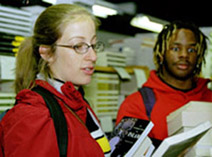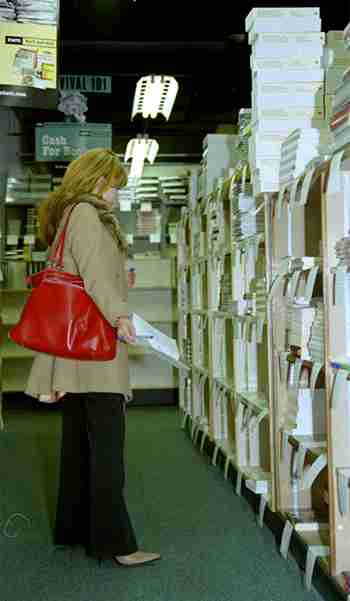With every new semester, students are faced with classes and one long wait in the bookstore to purchase books.
Snaking its way through a narrow hallway and down a flight of steps to the basement of the Danna Center is a queue of students — their arms filled with textbooks.
Jennifer Creel, English literature junior, will spend $350 this semester on books — a cost that she will cover entirely out-of-pocket.
The cost of textbooks is determined ultimately by the publisher. The publisher issues a retail price for the book and the bookstore sells the book at that price. However, another cost factor is whether the book is new or used.
According to Chris Cameron, director of the Danna Center and Student Services, the used book price cannot exceed 75 percent of the new book cost. Currently, the bookstore’s distribution is about 40 percent used books and 60 percent new books. Cameron says he would like to see those numbers reversed, which would allow students to save money.
Joseph Moore, French and chemistry freshman, is only paying about $150 for books this semester.
“I lucked out, all of my books are used,” he said.
Not far down the line is advertising sophomore Kristen Turner who is planning on spending about $400 on books this semester. Turner said that the reason for the high cost was “mostly because all of my major books are new first editions.”
One of the bookstore’s solutions to the high costs is a book adoption program. The program asks professors to submit a book adoption form by mid-term. The form asks the professor which books the class will use in the next semester.
The earlier the bookstore knows which texts will be used the following semester, the sooner it can start ordering books, as well as looking for used books.
Knowing if a book is going to be used the next semester improves the book’s buyback value, which puts more money into students’ pockets at the end of the semester.
If a book is slated for adoption in the next semester, the bookstore buys the book back at 50 percent of the book’s initial cost.
If the book will not be used the next semester, the student only receives 25 percent of the book’s cost when selling it at the end of the semester.
According to Cameron, the problem arises when professors do not return the adoption forms on time and students have already begun selling their books back to the bookstore.
If the form is not returned, the bookstore assumes that the book will not be used and only pays the student 25 percent of the initial cost of the book. One of the problems with returning the forms on time is that they are due by mid-term, which can be a busy time for both students and professors.
Loyola’s book adoption program can save money for students, but Cameron said that Loyola’s participation in the program is “one of the lowest in the region.”
Dr. Mary Blue, an associate professor in the Communications Department, is more skeptical of the bookstore’s tactics.
“Show me some evidence that they [the bookstore] actually extend the savings, then I will think about ordering more promptly,” she said.
This raises another point of contention that Blue and other professors have expressed with the bookstore operations.
There have been occasions when she and other professors have ordered by mid-term and the textbook was still not stocked by the beginning of the semester.

Elizabeth Fizer, political science junior, and psychology senior Fred Johnson search for textbooks in the basement of the Danna Center. Students experienced long lines in the bookstore during the first week of classes. (Gillian Dicker)






